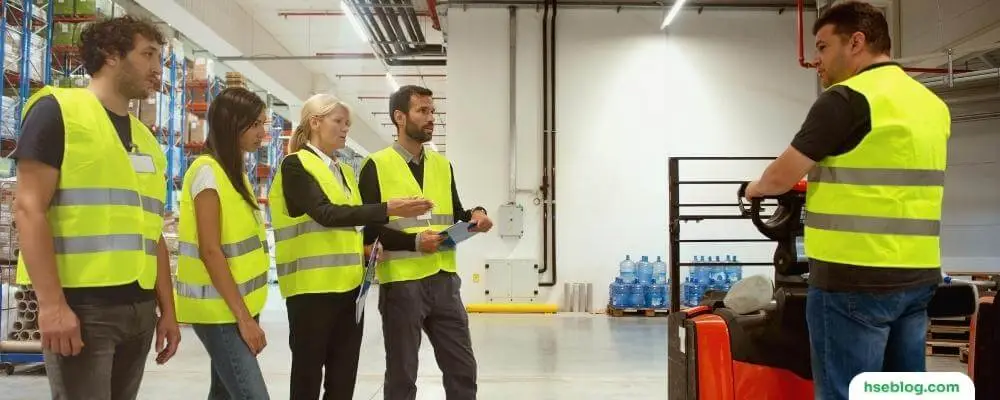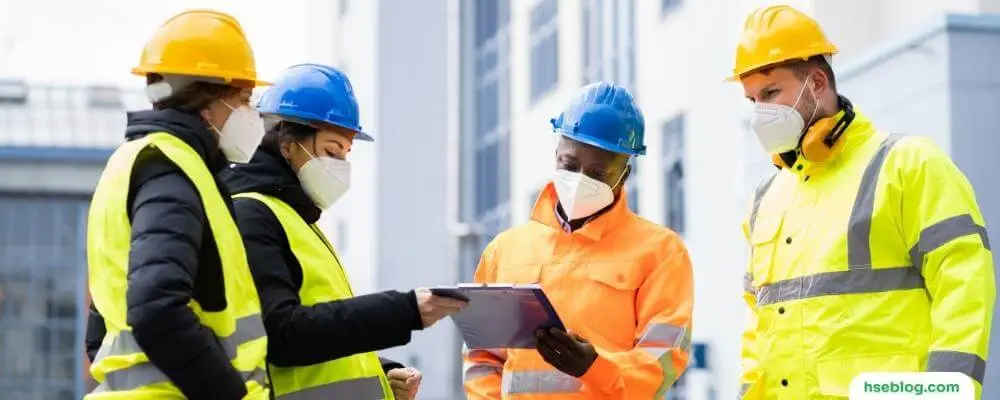Understanding the ins and outs of a Safety Committee is critical for fostering a safe and healthy work environment. In this blog, we delve into the definition, benefits, and responsibilities of a Safety Committee, shedding light on its essential role in today’s evolving workplace. We will explore a safety committee’s fundamental duties, its unique advantages to an organization, and how it can become a pivotal part of any company’s safety culture.
Whether you’re a business owner, a manager, an employee, or just someone interested in workplace safety, this blog is designed to provide a comprehensive overview of the vital Safety Committee concept. So, let’s start and unpack this pivotal workplace health and safety component.
What is a Safety Committee?
A Safety Committee is a group within an organization dedicated to enhancing workplace safety and health. It typically comprises representatives from different departments, including employees from various organizational levels.
The primary role of a Safety Committee is to identify potential hazards, risks, and safety issues in the workplace and develop plans and procedures to mitigate or eliminate those risks. It also promotes a safety culture among employees, encouraging adherence to safety procedures and protocols. The committee typically conducts regular safety audits, develops and delivers safety training, formulates safety and wellness programs, and serves as a platform for employees to raise safety-related concerns.
By doing so, the Safety Committee plays a crucial role in ensuring that the workplace is safe and healthy, thus protecting employees from potential injuries or illnesses and contributing to the overall productivity and well-being of the organization.

Benefits Of Health and Safety Committees
Health and Safety Committees can benefit an organization, contributing to the employees’ physical well-being and overall success. Here are some of the key benefits:
- Improved Safety Culture: Committees can help foster a culture of safety within the organization, emphasizing the importance of safety and ensuring it is a priority at all levels.
- Enhanced Communication: The committee provides a formal platform for open dialogue and communication about health and safety issues, fostering collaboration between employees and management in addressing these concerns.
- Identification of Hazards: Regular workplace inspections and risk assessments by the committee can help identify potential hazards early on before they lead to accidents or illnesses.
- Policy Development: Committees can assist in the creation, implementation, and review of health and safety policies and procedures, ensuring they are effective and align with legal requirements.
- Training and Education: The committee can play a vital role in developing and delivering health and safety training programs, ensuring all employees are properly informed about potential hazards and safe work practices.
- Enhanced Compliance: Health and safety committees help ensure that organizations comply with health and safety laws and regulations, reducing the risk of legal issues or penalties.
- Increased Employee Engagement: Committees often include representatives from all levels of the organization, giving employees a voice in health and safety matters and increasing their engagement and commitment to workplace safety.
- Lower Accident Rates: By promoting safe work practices and addressing potential hazards, committees can help reduce the number of workplace accidents and injuries, leading to lower workers’ compensation costs and improved productivity.
- Improved Worker Health and Well-being: By focusing on physical safety and wellness initiatives, health and safety committees can improve overall worker health and well-being, increasing job satisfaction and lower turnover rates.
Health and Safety Committees are critical in managing workplace health and safety, benefiting individual employees and the organization.

Roles and Responsibilities Of Safety Committee
The roles and responsibilities of a Safety Committee can vary depending on the specific needs and context of the organization. However, several core responsibilities are common in most settings. Here they are:
1. Developing and Implementing Safety Policies
The Safety Committee is often responsible for creating, implementing, and monitoring the effectiveness of the organization’s safety policies. This involves identifying potential hazards, developing strategies to mitigate these risks, and regularly reviewing and updating these policies as necessary.
2. Conducting Safety Inspections and Audits
Regular workplace inspections and audits are crucial for identifying and addressing potential safety hazards. The Safety Committee typically oversees these inspections, which may include checking equipment for defects, assessing the overall condition of the workplace, and ensuring all safety measures are being followed.
3. Training and Education
The Safety Committee usually plays a central role in developing and delivering employee safety training programs. This may involve educating staff about safety protocols, the correct use of safety equipment, how to respond to emergencies, and the importance of maintaining a safe work environment.

4. Incident Investigation
When workplace accidents occur, the Safety Committee is often responsible for investigating these events to understand their causes and prevent future occurrences. This involves reviewing incident reports, interviewing involved parties, and recommending corrective actions.
5. Communication
The Safety Committee is a vital communication link between management and employees regarding safety matters. It’s responsible for communicating safety policies and updates, addressing safety concerns raised by employees, and promoting a safety culture within the organization.
6. Compliance
The Safety Committee ensures the organization complies with all relevant local, state, and federal safety regulations. This includes staying up-to-date with any changes in safety legislation and ensuring these changes are implemented in the organization’s safety procedures.
7. Promotion of Health and Safety Culture
The Safety Committee helps foster a safety culture within the organization, where all employees understand the importance of safety, adhere to safety protocols, and feel comfortable raising safety concerns.
8. Emergency Planning
The Safety Committee is also tasked with developing and updating the organization’s emergency response plan. This plan should outline the steps to be taken in various emergency scenarios, and all employees should be trained.

Additional Roles and Responsibilities Of Safety Committee
- Record Keeping: The Safety Committee maintains records of all safety-related incidents, inspections, training, meetings, and policy changes. These records are crucial for tracking progress, identifying recurring issues, and demonstrating regulatory compliance.
- Risk Assessment: Regular risk assessments are necessary to identify potential hazards in the workplace. The safety committee should be involved in performing these assessments and using the results to improve safety policies and procedures.
- Safety Equipment Management: The committee is often tasked with ensuring that appropriate safety equipment is available, well-maintained, and used correctly. This includes personal protective equipment (PPE) like helmets, gloves, and masks, as well as safety devices on machinery.
- Encourage Employee Participation: An important role of the Safety Committee is to encourage all employees to participate actively in safety-related activities. This includes suggesting improvements, reporting hazards, and following safety procedures.
- Creating a Reporting System: The committee should establish a clear and straightforward system for employees to report safety concerns or incidents. This system should ensure that all reports are taken seriously, addressed promptly, and handled confidentially.
- Reviewing Workplace Changes: Any changes to the workplace—like the introduction of new equipment, changes in workflow, or building modifications—should be reviewed by the Safety Committee to assess their impact on safety.
- Health and Wellness Initiatives: Apart from occupational safety, the committee can promote general health and wellness among employees. This can include creating programs for stress management, ergonomics, nutrition, and physical activity.
- Addressing Specific Regulatory Requirements: Depending on the industry and the jurisdiction, there may be specific regulatory requirements that the Safety Committee needs to address. For instance, the committee must ensure compliance with specific construction safety standards in a construction company.
- Establishing Safety Performance Metrics: The Safety Committee should establish and monitor safety performance metrics to track the effectiveness of safety initiatives. These can include metrics like the frequency and severity of accidents, near misses, and safety training completion rates.
The Safety Committee can create and maintain a robust safety culture that prevents accidents and promotes employee well-being by taking on these roles and responsibilities.

Tips On How To Create an Effective Safety Committee?
Creating an effective safety committee involves careful planning, clear communication, and ongoing evaluation. Here are some tips on how to establish and maintain an effective safety committee:
- Define Clear Goals: The first step in establishing an effective safety committee is defining its purpose and goals. What specific safety issues or risks does the committee aim to address? How will the committee measure its success? The committee can focus its efforts and track progress by setting measurable goals.
- Diverse Membership: An effective safety committee includes representatives from various organizational levels and departments. This ensures various perspectives and promotes buy-in from all company areas. Additionally, including workers directly involved in daily operations can provide valuable insights into workplace safety issues.
- Regular Meetings: The committee should meet regularly, typically once a month or more often if necessary. Regular meetings keep safety at the forefront of everyone’s mind and provide an opportunity to discuss ongoing issues, review progress, and plan future actions.
- Training and Education: Committee members should receive training to help them understand safety principles, hazard identification, risk assessment, and relevant regulations. This knowledge will enable them to contribute more effectively to the committee’s work.
- Communication: Clear and open communication is essential for an effective safety committee. This includes communication among committee members and with the wider organization. The committee should keep all employees informed about its activities, decisions, and the reasons behind them.
- Review and Revise: The committee should regularly review its performance and effectiveness. Are the committee’s actions leading to improved safety? Are there areas where the committee could do better? The committee can improve its effectiveness by regularly evaluating and adjusting its approach.
- Make It Engaging: An effective safety committee keeps members engaged and interested. This can be achieved by rotating responsibilities, inviting guest speakers, and involving members in decision-making. Making meetings interactive and varied can also help to keep them engaging and productive.
- Encourage Employee Involvement: The more employees feel involved in safety initiatives, the more they will support them. The safety committee can encourage this by creating a safe space for employees to voice their concerns, suggestions, and ideas about workplace safety.
- Documentation: It’s essential to document all the activities, decisions, and measures the committee takes. This helps in tracking the progress and effectiveness of the committee over time. Documentation also serves as proof of compliance with safety regulations.
- Stay Updated: Safety regulations and best practices evolve over time, so the committee must stay updated. Regular training and seminars can help the committee keep up with the latest developments in workplace safety.
By following these tips, you can create a safety committee that is not just a formality but an effective tool for improving workplace safety.

How to Join a Safety Committee?
If you’re interested in joining a safety committee at your workplace, here are the steps you should follow:
- Express Interest: Communicate your desire to be part of the safety committee to your supervisor or the human resources department. They should be able to provide details about the committee, its functions, and the process of becoming a member.
- Understand Eligibility: There might be specific criteria for joining the safety committee, such as a certain number of years working within the organization or a specific level of experience or training. Make sure you meet these criteria before proceeding.
- Observe a Meeting: If possible, attend a safety committee meeting as an observer. This will provide a firsthand look at how the committee operates and what responsibilities you might assume as a member.
- Official Application: Once you’re comfortable with what being a safety committee member involves, formally apply. This might involve writing a letter of interest or filling out an application form.
- Active Participation: Once you’ve been accepted onto the safety committee, it’s essential to actively participate in meetings and other activities. Your input can help shape the direction of safety practices within the organization.
- Be a Role Model: As a safety committee member, you should lead by example. This means adhering to all safety procedures and policies and promoting a safety culture within your workplace. You can encourage your colleagues to do the same by demonstrating a commitment to safety.
Remember, joining a safety committee is not only a responsibility but also an opportunity to contribute positively to your workplace environment and the well-being of your colleagues.

Safety Committee Training Topics
Safety committee training topics are essential to ensure that the committee members understand their roles and responsibilities and are equipped with the knowledge to promote a safe work environment. Here are some example topics:
- Hazard Identification and Control: Training on identifying potential hazards in the workplace, how to control them, and preventive measures to be taken.
- Workplace Safety Laws and Regulations: Understanding the laws and regulations related to workplace safety is crucial. This might include training on OSHA regulations, state-specific safety laws, and industry-specific safety standards.
- Emergency Response Planning: This training focuses on planning for and responding to emergencies like fires, chemical spills, and medical emergencies.
- Workplace Ergonomics: This would cover the proper setup of workstations to prevent strain and injury, the right way to lift and carry items, and other ergonomics considerations.
- Safety Inspection Procedures: Committee members should be trained on how to conduct safety inspections, what to look for, and how to document their findings.
- Accident Investigation: Training on investigating workplace accidents to determine their causes and develop preventive measures.
- First Aid and CPR: Basic first aid and CPR training can be lifesaving in an emergency.
- Chemical Safety: For workplaces that use hazardous substances, training should cover how to safely handle these chemicals, the use of personal protective equipment, and procedures for spills or exposures.
- Workplace Violence Prevention: This might include training on recognizing potential signs of violence, de-escalation techniques, and what to do in a violent situation.
- Mental Health Awareness: Mental health is important to overall worker safety. This could include training on recognizing signs of mental health issues, resources for support, and strategies for stress management.
Remember that the specific topics needed for your safety committee may depend on the specific risks and hazards in your particular industry or workplace. Always make sure your training program is tailored to your needs.
Conclusion
In conclusion, a Safety Committee is fundamental to maintaining and enhancing workplace safety. Through its definition, roles, and responsibilities, it’s clear that such a committee significantly contributes to identifying potential hazards, developing and implementing safety procedures, and promoting a safety culture.
Understanding and leveraging its benefits are crucial for any organization to foster a secure, healthy, and productive work environment. By embracing the essence of a Safety Committee, businesses can proactively address safety issues, thus ensuring employee well-being and achieving operational efficiency.

